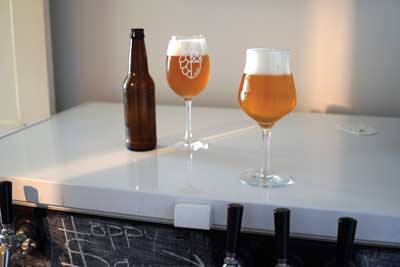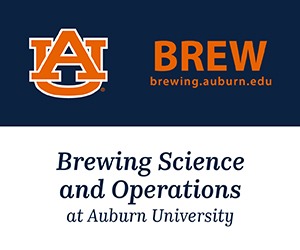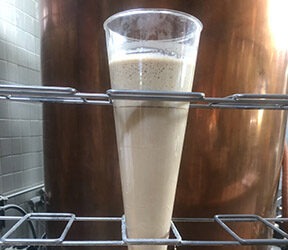Sour Sans Bacteria – Brewing with lactic acid-producing yeast

The most exciting finds so far are yeast that readily produce lactic acid; significantly those in the genera: Wickerhamomyces, Lachanacea, Zygosaccharomyces, Schizosaccharomyces, and Hanseniaspora. The pitch is that these “lactic acid yeast” can quickly sour beer without bacteria. The associated benefits are to eliminate the risk of bacteria infiltrating the cold-side equipment; streamline the process as compared to kettle souring; and encourage a unique yeast profile.
One of the things I got wrong in American Sour Beers (Brewers Publications, 2014) was when I wrote that Lactobacillus are able to produce a beer of standard alcohol content on their own. Subsequent tests by Lance Shaner of Omega Yeast demonstrated that even heterofermentative Lactobacillus, capable of producing ethanol and CO2, reduce the gravity of the wort by no more than about 0.004 (while creating less than 0.3% ABV)1. Yeast is required for substantial attenuation and alcohol production, but high amounts of lactic acid stresses brewer’s yeast (see “Acid Tolerance of Brewer’s Yeast” – BYO December 2016).
There is no way a single strain can replicate the depth and complexity of a spontaneous-fermented gueuze or a mixed-culture Flemish red. That is not our goal. Rather, lactic acid yeast have the potential to compete with kettle sours and other quick-souring methods. These techniques excel in beers that are tart and refreshing, or loaded with fruit that would obscure delicate flavors. Lactic acid yeast are especially intriguing for hoppy sours (“Hoppy Sour Beers” – BYO December 2016) because even without isomerization, hops inhibit Lactobacillus. Lactic acid yeast can sour a batch even with a large flame-out charge of hops.
My hot-take on lactic acid yeast was that they wouldn’t gain a foothold with brewers. I wasn’t sure if most would consider them any safer to introduce into their fermenters than Lactobacillus (which are easy to kill and inhibited by the hopping rate in most styles). A pure culture also reduces your control over the souring process, whereas with Lactobacillus you can step on the brakes with pasteurization or dry hops when you reach the desired pH. I also had not heard much about the flavors created by lactic acid yeast beyond lactic acid, not a good sign. I decided to try them for myself to see what they had to offer.
Where to Find Them
Like mineralogical prospectors some labs aren’t excited to share the exact location of their claims, while others know that most people would rather buy a ring than pan for gold. The two strains that I used from Wild Pitch Yeast were harvested from trees found on land in southwestern Pennsylvania: YH72 and YH82 were names given to these two particular strains.
While you can search for lactic acid yeast with sterilized swabs and petri dishes, it is nice to have a microbiologist do this work for you. Often it takes dozens of samples to find a useable isolate. Not only does the strain need to produce lactic acid, but it also must exhibit similar traits to brewer’s yeast: Attenuation (fermentation of maltose and maltotriose), fermentation speed, alcohol tolerance, lack of off-flavor production, flocculation, etc.
With these considerations in mind, I contacted Dr. Matt Bochman of Wild Pitch Yeast (WPY). He selected samples of two favorite strains for me to evaluate: YH72 Hanseniaspora vineae and YH82 Wickerhamomyces anomalus. Both strains were originally harvested from trees on Dr. Bochman’s parents’ land in southwestern Pennsylvania: YH72 from the bark of an ash and YH82 from a Shumard oak. WPY is eventually hoping to scale up production or partner with a yeast lab to make his strains more readily available to homebrewers, but for the moment WPY is focused on commercial pitches. Mainiacle Yeast sporadically has their own lactic acid yeast strains available to homebrewers through their website. I expect we’ll see more and more yeast labs introducing their own strains over the next year!
Lactic Acid Yeast Species
I’ve worked hard to dissuade brewers from the false notion that Brettanomyces produces the acidity in sour beers. Up until now it has been the bacteria, Lactobacillus and Pediococcus, that were responsible for lactic acid production. While both yeast and bacteria are microscopic, they are members of two separate kingdoms of life. Separated from bacteria by at least 1.5 billion years of evolution, fungi actually share a more recent common ancestor with humans than with either bacteria or plants.2 Considering that humans produce lactic acid (as a byproduct of generating energy from glucose without oxygen), it isn’t all that surprising that some yeast do so as well.
Hanseniaspora’s anamorph (asexual) form is Kloeckera; in the past Vinnie Cilurzo credited K. apiculata with providing grapefruit notes to Russian River Beatification. Given that K. apiculata can’t ferment maltose, it wouldn’t be effective for solo-fermentation. Luckily, this isolate of Hanseniaspora vineae can ferment wort well enough (reaching 71% apparent attenuation (AA) after three weeks in my tests). There is also some interesting research on H. vineae’s role in wine where it produced a “more fruity and flowery wine . . . strong presence of phenyl ethyl acetate.”3 This ester in particular is described as having an aroma like rose, raspberry, and honey.
Wickerhamomyces is intriguing in that it is positive for the enzyme beta-glucosidase as is Hanseniaspora vineae.4 See “The Science of Hop Glycosides” BYO July/August 2015 for more about how this enzyme frees interesting aromatics from hops and fruit. Some strains of Wickerhamomyces anomalus produce compounds that inhibit susceptible yeast (causing issues for co-fermentation with Saccharomyces). Luckily YH82 does not harm brewer’s yeast. It was a bit more attenuative in my tests, reaching 81% AA in three weeks. Another isolate of this species is available with several other oxidative yeasts in East Coast Yeast ECY31 Senne Valley Blend.
A paper by Claire Ingrid Svendsen describes her experience fermenting with Lachancea thermotolerans NCSU. The name refers to its need for cool temperatures. The species was previously known as Kluyveromyces thermotolerans. This strain is more attenuative, taking the sample 1.057 wort to 1.005, while simultaneously reducing the pH to 3.6.5 It too has been used experimentally in co-fermentation with Saccharomyces to increase acidity in wine fermentations.6
Another yet unnamed species is simply referred to as “GY7B.” When I talked to (discoverer) Dr. Matt Farber, Director of USciences Brewing Science Program, he indicated that they are still investigating commercial partners for releasing the strain. Their general timeline appears similar to others mentioned above, with relatively rapid acid production down to a pH of 3.5 in as little as five days, followed by complete attenuation (~95%) in two to three weeks. One novel note is that “GY7B” is a good glycerol producer, which can help improve mouthfeel. They also note it produces some apple esters,7 which seems to be common among lactic acid yeasts.
Brewing Considerations
I suggest treating these strains like brewer’s yeast unless you have specific guidance to the contrary. Pitch a healthy culture of a similar size to brewer’s yeast, aerate, and add yeast nutrient. In general, fermentation temperatures similar to ales or even Belgian strains are typical (68-80 °F/20-27 °C). As you might expect, warmer temperatures increase the rate of fermentation.
The mechanism by which these strains produce lactic acid is still a topic of discussion and research. One hypothesis, put forward by Svendsen, is that fermentation proceeds normally on the path from sugar to ethanol. The break from routine occurs at the final step: Rather than acetaldehyde being converted into ethanol, the enzyme lactate dehydrogenase converts it to lactic acid. As in our muscles, this is a process best suited for an anaerobic environment, so don’t expect a large amount of acidity in a starter grown on stir-plate. Bochman suggested that the affinity for simple sugars might suggest a low mash temperature able to boost lactic acid production.
I wanted to try the Hanseniaspora and Wickerhamomyces provided by Wild Pitch Yeast in a relatively bland base, plus a beer with aroma hops to take advantage of their hop-tolerance. Accordingly, I ran off two gallons (8 L) of wort post-boil through my plate-chiller. I then sent additional cooled wort back into the kettle, lowering the wort to 175 °F (79 °C) for the whirlpool addition of Mosaic® and Amarillo®. I have found that a cooler whirlpool retains no more hop aroma than a similar addition at flame-out, but it does reduce alpha acid isomerization and thus bitterness. While the yeast were billed as not minding iso-alpha acids, intense sour and bitter flavors are incompatible.
While the hoppy portions eventually finished at the same final gravity as their low-hopped counterparts, both took longer (especially Hanseniaspora). I was worried when attenuation was only at 25% after a week at 70 °F (21 °C) despite a quick start. This slow progress may have been a result of a factor other than hops (I didn’t precisely measure out the yeast when pitching). In a time-sensitive situation, pitching an aggressive brewer’s yeast in tandem or staggered may be beneficial (although potentially tricky given the kill factor some Wickerhamomyces can produce). Pitching brewer’s yeast could also serve to minimize continued acid production.
After dry hopping, the hoppy-versions were both good, but generally similar to Lactobacillus with a mild Belgian strain than anything approaching a classic mixed-fermentation. The lactic acid provided a quenching acidity that balanced the malt and made the citrus-zesty hops sing. I had a slight preference for the Hanseniaspora, as it was slightly more acidic (pH 3.38 vs. 3.52) and had a hint of peppery spice.
Without aroma hops, both Hanseniaspora and Wickerhamomyces displayed cidery apple-like aromatics; in the case of Hanseniaspora pushing almost toward apple cider vinegar. I do wonder if this observation was related to residual acetaldehyde, despite a four-week primary fermentation and three weeks of bottle conditioning. These flavors were hidden behind the hops, so not that strong.
Compared to kettle souring, these lactic acid-producing yeast allow for a simplified process. No need to heat the wort to pasteurize after reaching the target pH, although you don’t have that level of control to instantly “lock-in” acidity as you do when kettle souring.
A video of my brewing process of these soured beers is available on YouTube: https://www.youtube.com/watch?v=xeTMqPF-cTc
Cross Contamination Concerns
The risk of unwanted microbes taking up residence in your equipment can be evaluated on a sliding scale. As brewers we usually talk about sanitation (reducing microbes by at least 99.9%) rather than sterilization (99.999%). That may not seem like a significant difference, but it is equivalent to reducing 1 million cells to 1,000 or 10. Even with ideal process, some cells may survive into a subsequent batch. While a potential concern, in most cases the 100 billion new cells you add out-compete any maimed stragglers. Under ideal circumstances, you should reserve post-boil equipment for a single yeast strain, but this isn’t practical as brewers like yeast variety. More attenuative yeast strains, especially those capable of fermenting dextrins, offer bigger concern. Brett and hyper-attenuative Saccharomyces cerevisiae var. diastaticus fall into this category.
Conversely most lactic acid yeast are less concerning, so if you can get rid of a hyper-attenuative French saison, you should be fine with them as well. That said, Wickerhamomyces and Hanseniaspora are found in lambics months into fermentation.8 That suggests that they can grow from a few cells initially in post-Saccharomyces-fermentation conditions, which worries me a little. What makes a dangerous microbe isn’t necessarily that it is hard to kill (although some are), but rather that it can reproduce and work in difficult conditions.
For me it was less of a risk to run my test batches through my sour gear and tempting a little extra acid or funk, rather than through my clean gear and risk those beers developing low-level acidity during storage.
Lactic Acid Yeast
To recap, lactic acid yeast show a great deal of potential. It isn’t often that I get the opportunity to brew a sour beer in a novel way. Only a couple craft breweries are playing with these microbes including Hellbender Brewing Co. (Washington, DC), and Saucy Brew Works (Cleveland, OH). I’m excited to keep working with these yeast, trying new isolates, and learning from what other brewers discover. This is a clear time when the price of a yeast is fully justified. Rather than just taking a microbe from a bottle of beer or a cell bank, microbiologists and yeast wranglers are getting out of the lab to investigate interesting microbes that could change the way we brew!
Sources
1 http://www.milkthefunk.com/wiki/100%25_Lactobacillus_Fermentation#Lance_Shaner.27s_Experiment
2 https://www.sciencedaily.com/releases/2006/10/061021115712.htm
3 https://www.ncbi.nlm.nih.gov/pubmed/27014252
4 https://onlinelibrary.wiley.com/doi/full/10.1111/1750-3841.12954
5 https://repository.lib.ncsu.edu/bitstream/handle/1840.20/33647/etd.pdf?sequence=1&isAllowed=y
6 https://www.ncbi.nlm.nih.gov/pubmed/23200661
7 https://beerandbrewing.com/a-surprise-in-the-yeast/
8 The Microbial Diversity of Traditional SpontaneouslyFermented Lambic Beer.
General Interest: https://www.craftbrewingbusiness.com/featured/heres-a-yeast-strain-makes-lactic-acid-and-the-yeast-only-beer-made-as-a-result/



